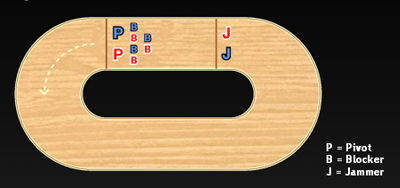Talk Derby To Me
Published on November 29th, 2007 in: Uncategorized |By Laura L.
If you were to tell my twelve-year-old self that in my mid-twenties I would be participating in a local roller derby league, I would have responded with: (1) “What’s roller derby?” and (2) an eye-roll, not necessarily in that order. Having been born in a time in which roller derby was at a down point, to put it lightly, I did not become familiar with the sport until a few years ago, when the modern roller derby revival had cropped up in Chicago and an acquaintance of mine took part in it. While today’s derby may have a punk, DIY edge to it, it did not start that way.
Let me take you back to Chicago and to the year 1935. During the Great Depression, dance marathons had become a popular spectacle, and promoter Leo Seltzer decided to capitalize on that, but in a different direction. Noticing the growing interest in roller skating among the public, he staged a roller skating marathon at a local rink. Skaters were to skate lap after lap, equaling the number of miles between New York and California. Along the way, folks began to fall, trip, and shove one another, and thus, roller derby was born.
The roller derby toured throughout the U.S., and starting in the 1950s, derby became a regular fixture on television. However, derby began to decline in popularity in the 1970s, as the spectacle took over the athleticism of the sport (think WWE on wheels). A few revivals were attempted, such as cable’s Roller Jam (aka “derby on inline skates”), but none caught on until a few years ago, when a group of ladies from Austin, Texas, decided to take to the track, but with a very distinct twist.

Roller Derby Track Model: Image from
the Windy City Rollers website
In the old days, roller derby took place on a banked track, which was often expensive to build and store. While some leagues still use a banked track, the majority use a flat track, e.g., a roller-rink floor, sport court, or a warehouse floor. With no need to store anything aside from rope lights to light and mark the boundaries of the track, derby can now be played pretty much anywhere. While derby had its own share of showmanship, the new school of derby focuses on real play and improvement of skills. Instead of a promoter-owned model, the primarily female derby leagues embrace a DIY ethic—”By the skaters, for the skaters.” In addition, a lot of skaters are tattooed and pierced, and many sport fishnets along with their uniforms. Most importantly, today’s skaters are usually required to wear protective gear, something that was in scant supply back in the day.
Before I begin the tale of my journey into the world of derby, let me explain how the game is played. Ten skaters—five on each team—enter the track in a pack formation. In the back of the pack are the jammers. Their mission is to score as many points as possible during a jam, or two-minute time period. Whoever breaks out of the pack first without stepping out of bounds is declared the lead jammer. The lead jammer gets to call off the jam, or end the time period prematurely, usually as a defense mechanism against the other team’s jammer. If no one is declared lead jammer, both must skate the entire two minutes. Points are scored for each time the jammer passes an opposing team’s player.
The blockers—three per team—are there to defend their respective teams’ jammers and prevent the opposing team’s jammer from scoring—usually by hitting the jammer shoulder-to-shoulder, among other techniques. The pivots—one per team—lead the pack as their respective teams’ last lines of defense. Pivots usually assist their jammers while trying to keep the opposing team’s jammers from sliding through the pack. There are major and minor penalties, and the game is 60 minutes in total—divided up into either two 30-minute periods or three 20-minute periods.
So what brought me to derby? A post-college malaise, the need to meet more weird souls like me, and the desire to kick ass. On one November night in 2005, I began that journey.
One Response to “Talk Derby To Me”
November 23rd, 2009 at 2:57 pm
[…] click here to read the […]
Time limit is exhausted. Please reload the CAPTCHA.